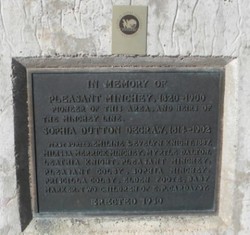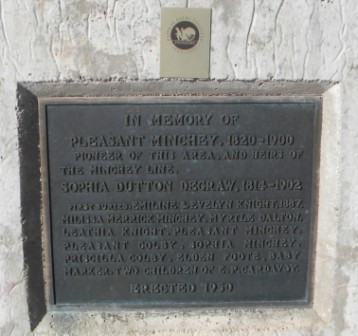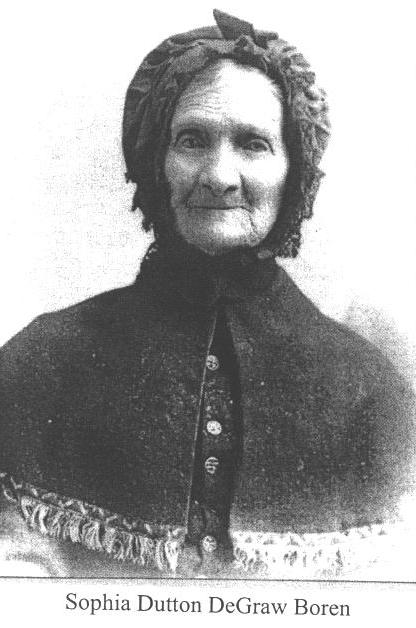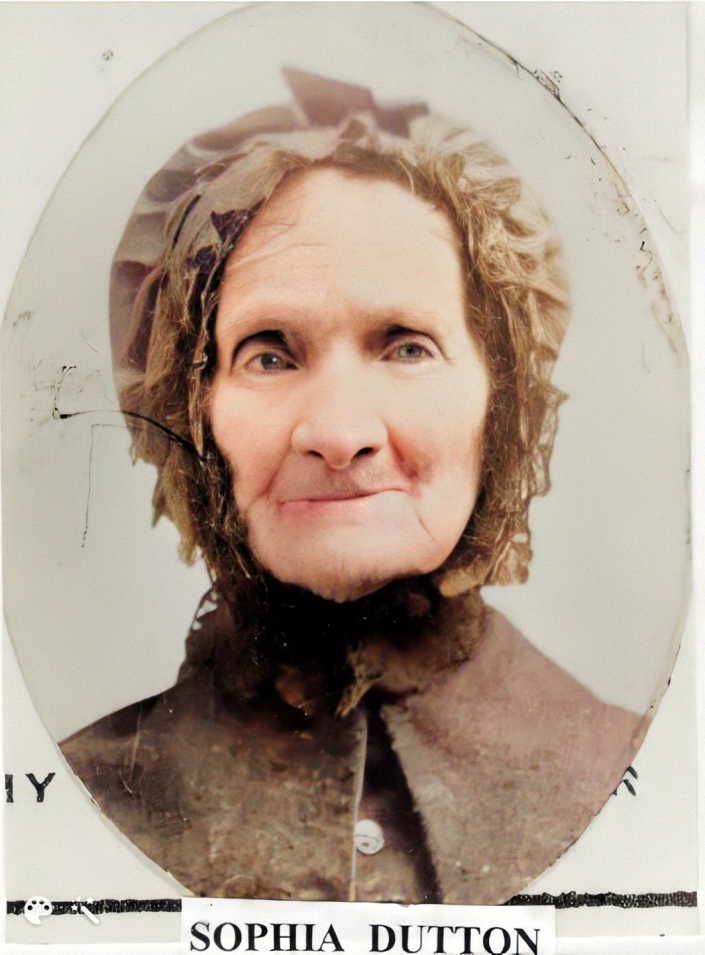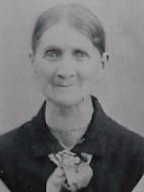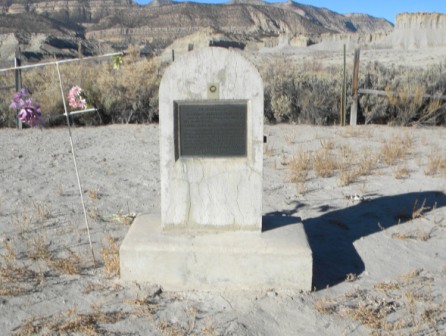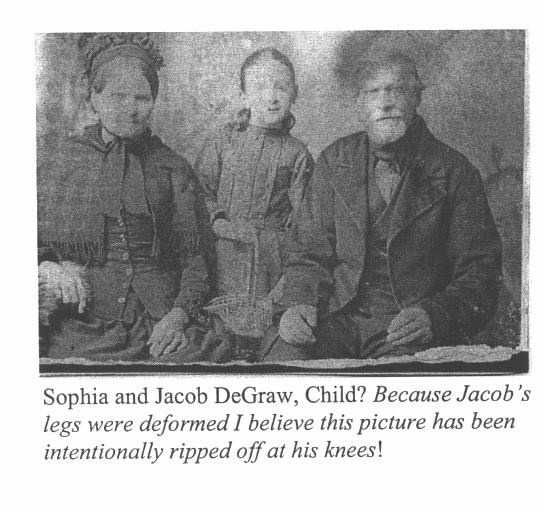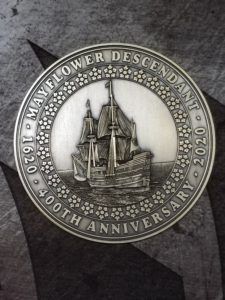Married Jacob DeGraw, 24 Aug 1833, Alexander, Genesse, New York
Children - Emaline Sophia DeGraw, Clarissa DeGraw, Eugene Lafayette DeGraw, Martha Jane DeGraw, Moroni DeGraw, Mary DeGraw, Elizabeth Rebecca DeGraw, Jacob DeGraw, Juliette DeGraw, Ellen Sophia DeGraw, Willis Boren DeGraw
Married William Willis Boren, 19 Dec 1856, Provo, Utah, Utah
History - Sophia Dutton was born 26 August 1814 in Hartford, Windsor, Vermont, a township located right on the Connecticut River across the state line of New Hampshire. She was the last child of ten children born to Benjamin Dutton and Clarissa Thomas. There is much research to be done as to how Sophia and Jacob De Graw met. Sophia's parents and siblings lived out their lives and died in Vermont.
Jacob married Sophia Dutton on 24 August 1833 in Alexander, Genesee, New York, a small town located almost midway between Buffalo and Rochester New York. Three years later, they had moved to north to Chinquacousy, Peel, Ontario, Canada where their second child, a daughter, was born 2 January 1836. They named her Clarissa after Sophia's mother.
By March 1838, they moved back to the United States and were living in Conesus, Livingston, New York when their son, Eugene Lafayette was born on 27 March. Conesus is about 20 miles south of Rochester in the western Finger Lakes region. Almost exactly two years later, they made a home in Alden, Erie, New York. Alden is less than ten miles due west of Alexander, New York, where Jacob and Sophia were married. They had come full circle in six and a half years. It was here that Martha Jane was born 4 March 1840. It was also here that Jacob and Sophia De Graw met a missionary from the Church of Jesus Christ of Latter-Day Saints named Brigham Young.
The Twelve Apostles in Nauvoo had been organized and called to make an expanded missionary effort and take the Restored Gospel of Jesus Christ to Great Britain. However, the mosquito born disease of malaria was plaguing many of the Saints including Brigham Young and Heber C. Kimball who were supposed to be departing Nauvoo 14 September 1840.
Brigham's wife Mary Ann had just given birth to a daughter, but Brigham answered the call, being sick himself, and crossed the river to join his companion. Both Heber and Brigham were too sick to start their mission. Three days later upon hearing of Brigham's debilitation, Mary Anne, still weak from child birth, ferried to Nauvoo and cared for her husband and Heber's entire family who were all bedridden except four-year-old Heber Parley, who could barely manage to carry water to the sick.
The next day, Heber and Brigham decided they could no longer delay their mission. Too weak to walk alone, they were helped into a wagon. As they drove away, Heber said he felt that "my very inmost parts would melt within me at leaving my family in such a condition, as it were almost in the arms of death. I felt as though I could not endure it. I asked the teamster to stop, and said to Brother Brigham, ‘This is pretty tough, isn't it; let's rise up and give them a cheer.' We arose, and swinging our hats three times over our heads, shouted; ‘Hurrah, hurrah for Israel.' Vilate, hearing the noise, arose from her bed and came to the door. She had a smile on her face. Vilate Kimball and Mary Anne Young cried out to us: ‘Goodbye, God bless you.'"
George Albert Smith joined Elder Kimball and Elder Young and they traveled by stagecoach East. They started their trip with only $13.50 in donations, and as they traveled Brigham always found just enough money in his trunk for the next stagecoach fare. When they reached New York and tallied the expenses of their trip, they calculated they had spent over $87 on coach fares alone. They had no idea how the additional money had gotten there "except by some unseen agent from the Heavenly world to forward the promulgation of the Gospel."
Brigham Young and his companions testified of the Restored Gospel as they traveled through New York State and Jacob and Sophia De Graw heard and embraced it. They were baptized by Brigham Young in 1840. Jacob and Sophia and their posterity are the beneficiaries of the toil and sacrifices paid by Brigham Young, Heber Kimball and their families.
After their baptism, Jacob moved his family to join with the rest of the Saints in Illinois. By 1840, Nauvoo had become the central gathering place for the Saints, but members of the church also established their own small settlements outside of Nauvoo such as Ramus, Lima, and Yelrome. Yelrome, named for its founder Isaac Morley, (Morley spelled backwards is almost Yelrome) was the neighboring community to Lima. The De Graws chose to settle in Lima, Illinois and were there before their fourth child Moroni was born on 28 May 1842. Jacob worked as a tailor, making suits and other apparel, and Jacob, not Sophia, did all the family's sewing. He even made a suit for Brigham Young.
The spring of 1843, Joseph Smith frequently visited the outlying settlements to teach and guide the Saints living there. Some of his sermons given in these settlements were so important that they were later included in the Doctrine and Covenants as section 130. Jacob and Sophia no doubt mourned the loss of the prophet Joseph after his martyrdom on June 27, 1844. Three and a half months later on 6 October 1844, a daughter, Mary, was born in Lima.
Despite the death of Joseph Smith, the Church communities not only survived, but they flourished. Enemies to the Church soon realized that murdering the prophet was not going to be the end of Mormonism and their antagonism intensified. In early September 1845, an organized mob of three hundred men first raided Yelrome and set fire to the unprotected homes, farm buildings, mills, and grain stacks there. They systematically unleashed the same terror in Lima and other surrounding communities. Jacob, Sophia, and their five young children were forced from their home as it was set ablaze. Brigham Young sent thirty-four teams to rescue the homeless Saints and bring the families in the outlying settlements to Nauvoo.
The De Graws lived as refugees in Nauvoo, and Jacob worked as a mason on the Nauvoo Temple. Even though conflict with non-Mormons in the surrounding counties were rising to a murderous level, the Saints continued to work to complete their beloved temple. Civil unrest continued until finally, on 24 September 1845, the Quorum of the Twelve Apostles promised its enemies that the Saints would abandon their beloved city the following Spring.
Work on the temple continued at a feverish pace and they planned to have a formal dedication of the temple in April 1846. As each room was completed, that room was dedicated so that ordinance work could begin as soon as possible. In October 1845, General Conference was help in the partially finished temple in which Brigham Young opened with a dedicatory prayer, "presenting the Temple, thus far completed, as a monument of the saints' liberality, fidelity, and faith…" Brigham also addressed the need to organize an orderly withdrawal from Nauvoo in the Spring, and go to a place far in the West where they would be free from persecution. The attic story was dedicated 30 November 1845 and ordinance work began there on 10 December 1845. Jacob and Sophia both received their own endowments in the Nauvoo Temple on 28 January 1846.
The main exodus of the Church from Nauvoo was originally planned for April, but threats prompted a hasty exit beginning on February 4, 1846. However, too many left Nauvoo who were not properly outfitted for fear of being left behind. The trek across Iowa proved the hardest as they were not prepared for the hardships due to lack of knowledgeable guides, delays, miserable weather, insufficient food, and difficult terrain. On 14 February it snowed and five days later a northwest wind brought 8 inches of snow. The mud had become deep from Nauvoo to Sugar Creek 9 miles to the west where the Saints had camped to wait for Brigham Young. A week later the temperatures dropped freezing the Mississippi over which allowed many Saints to cross on the ice.
Having had their home and most of their possessions burned in the mob attack in Lima, Jacob and Sophia did not have the provisions to go on with the Saints across Iowa. Jacob may have stayed to help finish the work on the Nauvoo temple, which was not completed until the end of April. Wilford Woodruff, Orson Hyde, and twenty others dressed in their temple robes, dedicated the Nauvoo Temple on 30 April, 1846. The following day, a public dedication ceremony was held. If the De Graws were still in Nauvoo, they undoubtedly would have attended the sacred ceremony.
Persecution began anew and enemies of the Saints were determined to drive every Mormon from the city. The Battle of Nauvoo took place in September, and it is assumed that Jacob was able to cross the Mississippi River with his family before the battle took place. Without a wagon to go west, the De Graws may or may not have been among the poor saints who were scattered in refugee camps for two miles along the riverbank. Church leaders had sent rescue wagons to help the stranded Saints, which arrived just in time to prevent starvation and the effects of winter exposure. Those rescued Saints were distributed throughout the various camps in Iowa. The De Graws stopped only 25 miles west of Nauvoo in Bonaparte, Van Buren, Iowa. There, Sophia gave birth to their sixth child, Elizabeth Rebecca, in Bonaparte on 28 May 1847. Jacob probably tried to procure work to earn provisions to continue West. It took the De Graws two years before they were able to make their way across Iowa to join the Saints still in Council Bluffs. On 29 October 1849, Sophia delivered a son, whom they named Jacob after his father.
Though Council Bluffs was a bustling staging ground for pioneers going west, the De Graws stayed her for nearly two and a half years. Sophia bore a second child here, a daughter they named Juliette born 1 February 1852. They probably did not have the funds necessary to buy enough provisions to get them to the Salt Lake Valley. The Church established the Perpetual Emigrating Fund in 1849, and used it in 1852 to bring in the remaining Saints still in Iowa.
The De Graws were probably some of those that benefited from those funds. They departed Council Bluffs in early July 1852 as part of Robert Wiemer's Company. It was a large company of 230 people and 130 wagons and arrived in the Salt Lake Valley 15 September 1852. Jacob and Sophia completed the trek with all eight children, the oldest child being 16 and their youngest just under a year. Some family records say that they traveled by handcart and pushed Jacob in it. However, the Weimer Company was a wagon company and the first handcart companies came four years later. It is entirely possible, though, due to their poverty, that the family made their own handcart to transport their crippled father along with what meager belongings and foodstuffs they had.
When they arrived in the valley, they settled in Lehi, Utah County. Another daughter, Ellen Sophia, was born 5 September 1855 in Lehi. Ellen Sophia may have been the final child of their union. Jacob apparently died sometime early in 1856 at the age of 45.
Sophia married William Willis Boren in December of 1856 and they moved to Provo. Sophia had another daughter listed as Emaline Sophia De Graw on 14 March 1859 in Santaquin, Utah. However, her father could not have been Jacob De Graw. Other records list her as Emaline Sophia Minchey, but that leaves the question of the origin of the name Minchey. Did Sophia marry a third time, or was that Emaline's married name?
Sophia Dutton De Graw Boren died 17 November 1902 in Emery, Emery, Utah at the age of 88.
Mormon Pioneer Overland Travel, Robert Wimmer Company (1852)
Married Jacob DeGraw, 24 Aug 1833, Alexander, Genesse, New York
Children - Emaline Sophia DeGraw, Clarissa DeGraw, Eugene Lafayette DeGraw, Martha Jane DeGraw, Moroni DeGraw, Mary DeGraw, Elizabeth Rebecca DeGraw, Jacob DeGraw, Juliette DeGraw, Ellen Sophia DeGraw, Willis Boren DeGraw
Married William Willis Boren, 19 Dec 1856, Provo, Utah, Utah
History - Sophia Dutton was born 26 August 1814 in Hartford, Windsor, Vermont, a township located right on the Connecticut River across the state line of New Hampshire. She was the last child of ten children born to Benjamin Dutton and Clarissa Thomas. There is much research to be done as to how Sophia and Jacob De Graw met. Sophia's parents and siblings lived out their lives and died in Vermont.
Jacob married Sophia Dutton on 24 August 1833 in Alexander, Genesee, New York, a small town located almost midway between Buffalo and Rochester New York. Three years later, they had moved to north to Chinquacousy, Peel, Ontario, Canada where their second child, a daughter, was born 2 January 1836. They named her Clarissa after Sophia's mother.
By March 1838, they moved back to the United States and were living in Conesus, Livingston, New York when their son, Eugene Lafayette was born on 27 March. Conesus is about 20 miles south of Rochester in the western Finger Lakes region. Almost exactly two years later, they made a home in Alden, Erie, New York. Alden is less than ten miles due west of Alexander, New York, where Jacob and Sophia were married. They had come full circle in six and a half years. It was here that Martha Jane was born 4 March 1840. It was also here that Jacob and Sophia De Graw met a missionary from the Church of Jesus Christ of Latter-Day Saints named Brigham Young.
The Twelve Apostles in Nauvoo had been organized and called to make an expanded missionary effort and take the Restored Gospel of Jesus Christ to Great Britain. However, the mosquito born disease of malaria was plaguing many of the Saints including Brigham Young and Heber C. Kimball who were supposed to be departing Nauvoo 14 September 1840.
Brigham's wife Mary Ann had just given birth to a daughter, but Brigham answered the call, being sick himself, and crossed the river to join his companion. Both Heber and Brigham were too sick to start their mission. Three days later upon hearing of Brigham's debilitation, Mary Anne, still weak from child birth, ferried to Nauvoo and cared for her husband and Heber's entire family who were all bedridden except four-year-old Heber Parley, who could barely manage to carry water to the sick.
The next day, Heber and Brigham decided they could no longer delay their mission. Too weak to walk alone, they were helped into a wagon. As they drove away, Heber said he felt that "my very inmost parts would melt within me at leaving my family in such a condition, as it were almost in the arms of death. I felt as though I could not endure it. I asked the teamster to stop, and said to Brother Brigham, ‘This is pretty tough, isn't it; let's rise up and give them a cheer.' We arose, and swinging our hats three times over our heads, shouted; ‘Hurrah, hurrah for Israel.' Vilate, hearing the noise, arose from her bed and came to the door. She had a smile on her face. Vilate Kimball and Mary Anne Young cried out to us: ‘Goodbye, God bless you.'"
George Albert Smith joined Elder Kimball and Elder Young and they traveled by stagecoach East. They started their trip with only $13.50 in donations, and as they traveled Brigham always found just enough money in his trunk for the next stagecoach fare. When they reached New York and tallied the expenses of their trip, they calculated they had spent over $87 on coach fares alone. They had no idea how the additional money had gotten there "except by some unseen agent from the Heavenly world to forward the promulgation of the Gospel."
Brigham Young and his companions testified of the Restored Gospel as they traveled through New York State and Jacob and Sophia De Graw heard and embraced it. They were baptized by Brigham Young in 1840. Jacob and Sophia and their posterity are the beneficiaries of the toil and sacrifices paid by Brigham Young, Heber Kimball and their families.
After their baptism, Jacob moved his family to join with the rest of the Saints in Illinois. By 1840, Nauvoo had become the central gathering place for the Saints, but members of the church also established their own small settlements outside of Nauvoo such as Ramus, Lima, and Yelrome. Yelrome, named for its founder Isaac Morley, (Morley spelled backwards is almost Yelrome) was the neighboring community to Lima. The De Graws chose to settle in Lima, Illinois and were there before their fourth child Moroni was born on 28 May 1842. Jacob worked as a tailor, making suits and other apparel, and Jacob, not Sophia, did all the family's sewing. He even made a suit for Brigham Young.
The spring of 1843, Joseph Smith frequently visited the outlying settlements to teach and guide the Saints living there. Some of his sermons given in these settlements were so important that they were later included in the Doctrine and Covenants as section 130. Jacob and Sophia no doubt mourned the loss of the prophet Joseph after his martyrdom on June 27, 1844. Three and a half months later on 6 October 1844, a daughter, Mary, was born in Lima.
Despite the death of Joseph Smith, the Church communities not only survived, but they flourished. Enemies to the Church soon realized that murdering the prophet was not going to be the end of Mormonism and their antagonism intensified. In early September 1845, an organized mob of three hundred men first raided Yelrome and set fire to the unprotected homes, farm buildings, mills, and grain stacks there. They systematically unleashed the same terror in Lima and other surrounding communities. Jacob, Sophia, and their five young children were forced from their home as it was set ablaze. Brigham Young sent thirty-four teams to rescue the homeless Saints and bring the families in the outlying settlements to Nauvoo.
The De Graws lived as refugees in Nauvoo, and Jacob worked as a mason on the Nauvoo Temple. Even though conflict with non-Mormons in the surrounding counties were rising to a murderous level, the Saints continued to work to complete their beloved temple. Civil unrest continued until finally, on 24 September 1845, the Quorum of the Twelve Apostles promised its enemies that the Saints would abandon their beloved city the following Spring.
Work on the temple continued at a feverish pace and they planned to have a formal dedication of the temple in April 1846. As each room was completed, that room was dedicated so that ordinance work could begin as soon as possible. In October 1845, General Conference was help in the partially finished temple in which Brigham Young opened with a dedicatory prayer, "presenting the Temple, thus far completed, as a monument of the saints' liberality, fidelity, and faith…" Brigham also addressed the need to organize an orderly withdrawal from Nauvoo in the Spring, and go to a place far in the West where they would be free from persecution. The attic story was dedicated 30 November 1845 and ordinance work began there on 10 December 1845. Jacob and Sophia both received their own endowments in the Nauvoo Temple on 28 January 1846.
The main exodus of the Church from Nauvoo was originally planned for April, but threats prompted a hasty exit beginning on February 4, 1846. However, too many left Nauvoo who were not properly outfitted for fear of being left behind. The trek across Iowa proved the hardest as they were not prepared for the hardships due to lack of knowledgeable guides, delays, miserable weather, insufficient food, and difficult terrain. On 14 February it snowed and five days later a northwest wind brought 8 inches of snow. The mud had become deep from Nauvoo to Sugar Creek 9 miles to the west where the Saints had camped to wait for Brigham Young. A week later the temperatures dropped freezing the Mississippi over which allowed many Saints to cross on the ice.
Having had their home and most of their possessions burned in the mob attack in Lima, Jacob and Sophia did not have the provisions to go on with the Saints across Iowa. Jacob may have stayed to help finish the work on the Nauvoo temple, which was not completed until the end of April. Wilford Woodruff, Orson Hyde, and twenty others dressed in their temple robes, dedicated the Nauvoo Temple on 30 April, 1846. The following day, a public dedication ceremony was held. If the De Graws were still in Nauvoo, they undoubtedly would have attended the sacred ceremony.
Persecution began anew and enemies of the Saints were determined to drive every Mormon from the city. The Battle of Nauvoo took place in September, and it is assumed that Jacob was able to cross the Mississippi River with his family before the battle took place. Without a wagon to go west, the De Graws may or may not have been among the poor saints who were scattered in refugee camps for two miles along the riverbank. Church leaders had sent rescue wagons to help the stranded Saints, which arrived just in time to prevent starvation and the effects of winter exposure. Those rescued Saints were distributed throughout the various camps in Iowa. The De Graws stopped only 25 miles west of Nauvoo in Bonaparte, Van Buren, Iowa. There, Sophia gave birth to their sixth child, Elizabeth Rebecca, in Bonaparte on 28 May 1847. Jacob probably tried to procure work to earn provisions to continue West. It took the De Graws two years before they were able to make their way across Iowa to join the Saints still in Council Bluffs. On 29 October 1849, Sophia delivered a son, whom they named Jacob after his father.
Though Council Bluffs was a bustling staging ground for pioneers going west, the De Graws stayed her for nearly two and a half years. Sophia bore a second child here, a daughter they named Juliette born 1 February 1852. They probably did not have the funds necessary to buy enough provisions to get them to the Salt Lake Valley. The Church established the Perpetual Emigrating Fund in 1849, and used it in 1852 to bring in the remaining Saints still in Iowa.
The De Graws were probably some of those that benefited from those funds. They departed Council Bluffs in early July 1852 as part of Robert Wiemer's Company. It was a large company of 230 people and 130 wagons and arrived in the Salt Lake Valley 15 September 1852. Jacob and Sophia completed the trek with all eight children, the oldest child being 16 and their youngest just under a year. Some family records say that they traveled by handcart and pushed Jacob in it. However, the Weimer Company was a wagon company and the first handcart companies came four years later. It is entirely possible, though, due to their poverty, that the family made their own handcart to transport their crippled father along with what meager belongings and foodstuffs they had.
When they arrived in the valley, they settled in Lehi, Utah County. Another daughter, Ellen Sophia, was born 5 September 1855 in Lehi. Ellen Sophia may have been the final child of their union. Jacob apparently died sometime early in 1856 at the age of 45.
Sophia married William Willis Boren in December of 1856 and they moved to Provo. Sophia had another daughter listed as Emaline Sophia De Graw on 14 March 1859 in Santaquin, Utah. However, her father could not have been Jacob De Graw. Other records list her as Emaline Sophia Minchey, but that leaves the question of the origin of the name Minchey. Did Sophia marry a third time, or was that Emaline's married name?
Sophia Dutton De Graw Boren died 17 November 1902 in Emery, Emery, Utah at the age of 88.
Mormon Pioneer Overland Travel, Robert Wimmer Company (1852)
Family Members
-
![]()
Emeline DeGraw Minchey
1834–1912
-
![]()
Clarissa DeGraw Robertson
1836–1912
-
![]()
Eugene Lafayette De Graw
1838–1910
-
![]()
Moroni DeGraw
1842–1911
-
![]()
Mary DeGraw Billingsley
1844–1899
-
![]()
Elizabeth Rebecca DeGraw Baldwin
1847–1881
-
![]()
Jacob Degraw Jr
1849–1926
-
![]()
Juliaette DeGraw Hampton
1852–1940
-
![]()
Ellen Sophia Degraw Frederick
1855–1920
-
![]()
Willis Boren
1859–1943
Sponsored by Ancestry
Advertisement
Records on Ancestry
Sponsored by Ancestry
Advertisement
